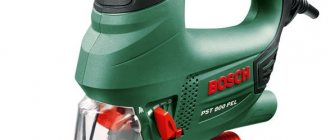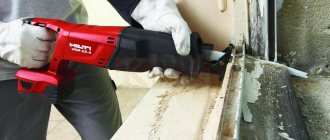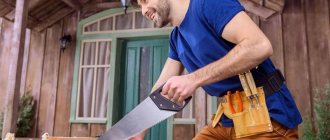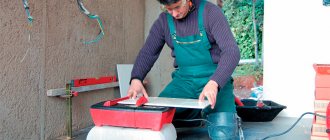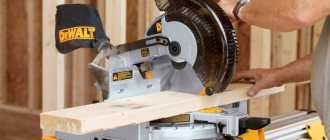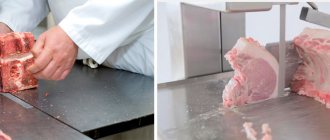Choosing the right tool
First, you need to choose the right power tool based on your own needs. It is important to understand that the more powerful the device, the greater its weight. This will directly affect the further ease of use. Therefore, you should not purchase a tool paying attention solely to its power.
When choosing, you need to pay attention to some useful additions to the device. For example, lighting and airflow can actually often come in handy when working with a jigsaw. It is also recommended to purchase models with stepwise speed control, electronic stabilizer, and pendulum stroke. All this will greatly simplify woodworking.
Before paying money for a tool, it is recommended to hold it in your hands and make sure it is comfortable. Some stores allow customers to try out a new tool on site, so it’s a good idea to take advantage of this opportunity.
Selection of cutting blade
For an even cut, it is important to choose the right cutting blades. They are classified according to the length and frequency of the teeth. Regardless of the type of fabric, it is better to give preference to trusted manufacturers. Basically, blades of models No. 3, No. 5, and No. 7 are purchased for working with a manual jigsaw, but there are exceptions.
Classification of paintings:
- standard - files with teeth of the same size, oriented in the same direction at an equal distance;
- blade with a missing tooth - the cutting element has one tooth missing in turn. This increases the cutting speed and reduces the heating of the file.
- double teeth - the speed of working with such a blade is noticeably reduced, but the quality of the cut is many times better;
- reversible - thanks to the teeth located on the reverse side of the blade, you can cut the material without chipping.
Marking the cut line
For a neat cut, marking the cut line plays a very important role. The first step is to use a ruler and pencil to draw all the necessary lines according to the required dimensions. If shaped cutting of material is required, you should initially apply it to paper and then transfer it to the material using carbon paper.
Next, you need to use a straight strip as a guide. Without it, the jigsaw blade can easily move to the side, and the workpiece will be damaged. Some models of jigsaws have a laser beam, which helps to orient the tool more evenly, but you should not neglect the guide rail.
To cut out a circle, markings are made according to a pre-made stencil. A hole is drilled in the center of the circle, and the canvas is drawn from it to the edges of the marking and cut around the perimeter.
Cutting the workpiece
Working with semi-finished products consists of several stages:
- Familiarization with the processed material and its properties.
- Selection of cutting mode, selection of the necessary cutting tool (file), auxiliary equipment.
- Checking the functionality of the jigsaw, the serviceability of individual elements, the absence of play in moving parts.
Cutting down a tree
Stages of work:
- The technical capabilities of the jigsaw are checked with the geometric parameters of the workpiece and the material being processed:
- Working stroke – part thickness – saw blade length.
- Type of wood – saw blade thickness – tooth size.
- Wood properties - cutting mode (stroke frequency).
- The need for a pendulum function. For a clean cut, the function is disabled. Speed is important - a pendulum motion is used, but the cutting accuracy is reduced.
- The issue of using additional equipment is being considered. The decision depends on the requirements for the evenness of the cut and the magnitude of the errors.
- The workplace is being prepared. The main characteristic of the stand is to ensure strength, rigidity and stability. Another property is the flatness of the table surface.
- The cutting line is marked. If there are no restrictions on line brightness, then it is advisable to use a black marker. In another option, it is advisable to use a pencil - its marks can be wiped off with a student eraser.
- The workpiece is fixed on the table. The main requirement is a strong fixation that limits movement on all sides. The protruding part, if necessary, is weighted with additional supports. This is necessary to reduce the influence of the cut mass on the main part and the file. It is necessary to ensure free movement of the cutter in a vertical position.
Wood cutting
A jigsaw connected to the mains is installed on the surface of the workpiece. The front part of the platform should fit snugly against the workpiece. Deviations from these recommendations can lead to impact at the beginning of cutting, increased vibration, and the saw moving off the path.
The “Soft Start” function helps to increase the initial accuracy - the engine smoothly picks up speed, the cutting process is carried out in normal mode. The jigsaw must be moved slowly, without jerking, at low speed. Constantly carry out visual control over the position of the cutting point and marking.
A laser beam, illumination of the cutting line and blowing help in this process - it removes chips from the markings. Greater cutting accuracy will be ensured by tracking the file itself, or more precisely, the place of contact with the workpiece.
Recommendations
- Thick pieces of soft wood, more than 40~60 mm, must be cut at a minimum longitudinal feed. Increasing the pressure in this direction will increase the risk of curvature of the cutting plane - the lower part of the cut will move 1~5 mm to one side. That is, an inclined cut is formed. These recommendations are valid for dense and hard wood, glued products, but with less thickness.
- It is advisable to carry out longitudinal cutting (along the grain) of wood with the pendulum function turned on. In addition to increasing the processing speed, the likelihood of the file moving to the side will be reduced and the cutting accuracy will increase.
- The use of auxiliary equipment is not a panacea; you should not rely entirely on devices. Constant control over the progress of the process is required - it is better to interrupt sawing in time than to make an irreparable mistake.
- It is advisable to use a side stop when the side of the part has a flat edge. You can check it with a ruler, a carpenter's square, a rule, or a laser level.
- An increase in cutting resistance is evidence of dull saw teeth. Another indicator is strong heating of the cutting tool, a change in color, up to blue-iridescent shades.
Processing of laminated wood
The difference from ordinary wood is the application of several layers of additional coating on one or both sides. One of them, on the front part, performs strength, protective and decorative functions. For example, laminate, parquet boards, furniture panels.
A special feature of the processing is the maximum preservation of the front surface during the cutting process. Requirements for fastening are similar to wooden blanks. The nuance is in the location of the part itself, up or down with the front part. It depends on the saw - with forward or reverse motion.
Chips on the surface are formed on the side facing the jigsaw in forward mode - the saw teeth are directed upward. The adjustment involves turning the product face down. Another option is to use a tool with downward-pointing cutters. The negative effect is increased vibration during processing.
Recommendations
- The pendulum stroke is disabled.
- Maximum stroke rate.
- File for a clean cut. On the side there is the inscription “clean cut” or “clean”.
- The tooth size is no more than 2 mm. It is allowed to use a metal file.
Curvilinear cut
Making curved lines and circles is one of the types of processing, for which, in fact, a jigsaw is needed.
Creating a hole:
- A hole is drilled in the body of the workpiece, with a diameter larger than the size of the file by 2~3 mm.
- A cutter is passed inside the freshly made opening.
- The transition to the main cutting line is carried out along a curved path - along an arc.
Recommendations
- The accuracy of a curved cut will be ensured by a narrow file, called a “file for figured cutting.”
- Increasing the cutting accuracy is the use of a stop-compass.
- Mode: maximum stroke rate, minimum longitudinal feed (movement along the cutting line), pendulum stroke disabled.
- Cutting the surface without drilling:
- The front edge of the sole is set outside the markings at an angle to the plane of the workpiece, approximately 45~60 degrees.
- Reducing the inclination, smoothly bring the file to the surface of the workpiece. Without applying pressure, the parts are cut into the body.
- Bring the sole to the plane without interrupting the cutting process.
- Continue cutting along the required trajectory.
In this method, internal holes are made, with a curved (oval, circle) generatrix or at different angles between adjacent sides (rectangle, rhombus, trapezoid).
We saw metal
Features – the thickness of the workpiece, depending on the power of the jigsaw and the type of steel, does not exceed 10~12 mm.
Cutter, mode:
- Metal file, tooth no more than 1 mm (outwardly resembles a 300 mm saw blade for a hacksaw for metal). The inscription is metal.
- The stroke frequency is minimal.
- The pendulum mechanism is not activated.
Recommendations
- A thin workpiece (up to 2~5 mm), in order to increase the cutting accuracy, reduce vibration, and chatter, must be secured between two sheets of furniture fiberboard. Markings should be made on the auxiliary surface.
- Metal, due to increased loads during sawing, must be carefully secured. Ensure free movement of the saw blade in a vertical position.
- The long end of the cut part is fixed in an additional support.
- The initial moment of sawing should be very smooth, without any sudden contact of the file with the metal.
- Increased accuracy is facilitated by the use of a lubricant - machine oil is applied in drops along the cutting line.
- It is advisable to cut thick workpieces with breaks to cool the file and jigsaw.
Sawing tiles
A jigsaw is successfully used for processing tiles or natural stone. Process Feature:
- A combination of fragility and strength of the material.
- Increased hardness and abrasiveness.
- Accelerated cutter wear.
- The pendulum mechanism is disabled.
- Minimum speed.
- Using a special file with applied abrasive material (diamond chips, electrocorundum, etc.).
- Smooth movement along the cutting line at low feed.
A jigsaw is convenient for making curved cuts on tiles; other methods are complex and require special equipment.
The requirements for fixing the product are similar to those for other materials. It is recommended to use water or oil wetting - this improves cutting conditions and increases processing accuracy.
Technology for making an even cut
To ensure an accurate cut, you should adhere to some nuances:
- Do not put too much pressure on the device during operation. In this case, the canvas may break, and defects may appear on the material.
- When cutting a steel sheet, you need to use a powerful tool and work at maximum speed. When heated by friction, the metal will become more malleable.
- Working with plastic, org. When working with glass or metal, it is important to take periodic breaks from working so that the cutting element has time to cool down.
- To avoid melting the plastic when cutting it, you should work with this material only at low engine speeds.
- To ensure accurate figure cutting, you should choose a narrow blade with small teeth.
All these recommendations will help you learn how to cut smoothly with a jigsaw, even if it seems to you that this is impossible.
How to cut chipboard without chipping?
Before we start cutting chipboard, especially laminated chipboard, we cut a line along which we will cut with a sharp tool and glue paper tape with an adhesive layer along it. This will help minimize damage to the decorative chipboard layer.
If chips still cannot be avoided, we process the cut first with a file, working in the direction from the edges to the center, and then with fine-grained sandpaper. You can also mask all defects by using, where possible, a flexible profile.
Currently reading: Jigsaw Teeth
